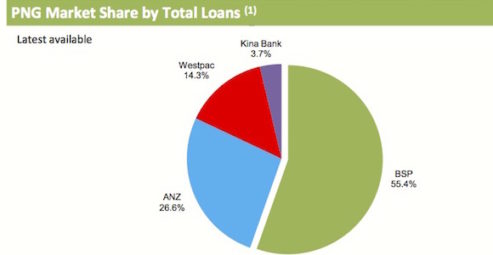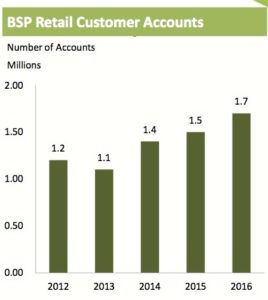Sir Kostas Constantinou, the Chairman of Bank South Pacific (BSP), has indicated the bank is considering a listing on the Australian Securities Exchange (ASX). Looking at some common ways of assessing a bank’s suitability for investment, how does Papua New Guinea’s largest bank measure up to Australia’s banks?

BSP’s market share of loans in PNG Source: Bank South Pacific
The banking markets in PNG and Australia are very different, meaning that any comparison between PNG banks and those in Australia should be treated with caution. For example, most lending in Australia is typically backed by property, whereas in PNG that is less common because of the customary ownership of land. The regulatory regimes are also different.
But, on many of the financial fundamentals, BSP looks strong when compared with its Australian counterparts.
Capital Adequacy
One of the biggest differences between Bank South Pacific and the Australian banks is capital adequacy. This is a measure of how much capital is retained by the bank to deal with crises (such as a sudden outflow of funds). BSP’s capital adequacy levels are very high by world standards.
According to a BSP analyst presentation, its Tier 1 capital (capital held in reserve in case of problems) is currently 19.8 per cent. This is about three times what is required by the so-called Basel III rules which have, since 2015, required that a bank’s Tier 1 capital must be at least 6 per cent of its risk weighted assets.
‘The bank’s ‘strong capital adequacy and liquidity position’ is enhanced by having ‘more than half of total banking sector assets held in government securities or cash.’
BSP’s combined level of Tier 1 and Tier 2 capital (23.8 per cent) is also about three times the internationally stipulated minimum.
Australian banks are not as well protected. According to a report by Macquarie Wealth Management, the ANZ’s Tier 1 capital is 9.6 per cent, Commonwealth Bank’s is 9.9 per cent, the National Australia Bank’s is 9.8 per cent and Westpac’s is 11.2 per cent.
Moreover, as the BSP analyst report notes, the bank’s ‘strong capital adequacy and liquidity position’ is enhanced by having ‘more than half of total banking sector assets held in government securities or cash.’
Profitability
There are many measures of a bank’s profitability. One of the most commonly used is return on equity (how much profit a company generates relative to its shareholders’ equity).

BSP’s retail customer accounts Source: Bank South Pacific
Here too, BSP looks strong. According to the bank’s analyst presentation, the return on equity for the 2016 financial year was 29.6 per cent. It is projected to be 28.1 per cent for the 2017 financial year.
This is very high by world standards and about double the level of profitability of the Australian banks.
According to the Macquarie report, the return on equity (RoE) of the four major Australian banks ranges from 11.6 per cent (ANZ) to 16 per cent (Commonwealth Bank).
Dividends
One area where BSP is disadvantaged, at least from an Australian investors’ perspective, is dividends. Dividends from Australian banks are tax-free in the hands of local investors to the extent that the company has already paid company tax on them (called dividend imputation).
‘It means that for Australian investors A$1 of BSP dividends would be worth less on an after-tax basis than A$1 from an Australian bank.
This tax advantage advantage does not apply to foreign companies listed on the ASX, including PNG companies.
For Australian investors, it means that A$1 of BSP dividends would be worth less on an after-tax basis than A$1 from an Australian bank.
Yet, even after taking this into account, BSP looks competitive. The bank is anticipating paying out 74 per cent of its profits as dividends–about the same payout ratio as Australian banks–and the projected dividend yield is 12 per cent.
According to a report by Deutsche Bank, the projected dividend yields of the Australian banks are about half that: ranging from 5.2-6 per cent for 2017.
Moreover, the tax advantage does not apply to many ASX investors. About two-fifths of the shares on the ASX are held by foreigners who do not benefit. They may find BSP’s dividends more attractive.
Turnover
If BSP does list on the ASX, it will mean much greater turnover in its shares and it will probably attract the interest of large financial institutions in Australia. The bank will also automatically receive investment from the Exchange Traded Funds (ETFs or index funds).
‘If this measure is taken in isolation, it suggests that BSP’s shares are trading at half the level of the shares of the Australian banks.’
What is likely to happen to the share price? According to BSP’s 2016 full-year results, the company traded last year on an earnings multiple of 6.5 times (the earnings multiple, or price-earnings ratio, is considered the main indicator of the share price: the higher the earnings multiple, the more expensive the shares are considered).
According to a report by Deutsche Bank, the major Australian banks are trading on prospective earnings multiples of 13.8 to 15 times. If this measure is taken in isolation, it suggests that BSP’s shares are trading at half the level of the shares of the Australian banks. Another possibly relevant indicator is that the dual-listed PNG bank Kina Securities is trading on about 10 times its earnings.
Investing is never simple or predictable; there are many competing considerations. One thing that will concern Australian investors is how movements in the kina may affect dividend payments. Inflation is also higher in PNG than Australia, which will create concern.
But there seems some evidence that BSP could be attractive to Australian investors if the bank decides to make the jump to dual listing.









Speak Your Mind